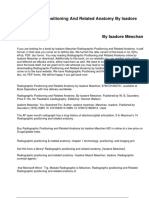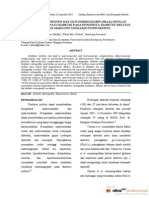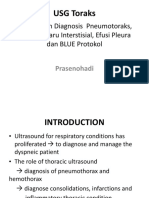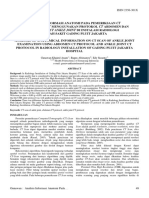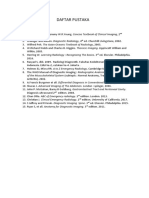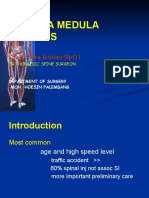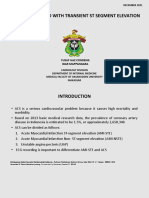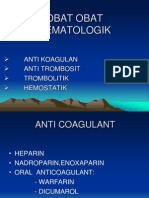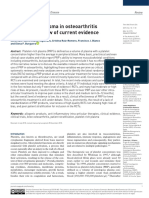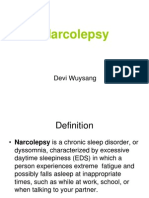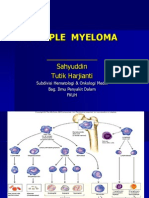0 ratings0% found this document useful (0 votes)
147 views(Radiology) RADIOLOGI
(Radiology) RADIOLOGI
Uploaded by
Irham KhairiThis document discusses various radiological modalities used in neuropsychiatry including plain skull x-rays, CT scans, MRI, ultrasound, angiography and myelography. It provides examples of abnormalities that can be detected on each imaging type such as tumors, infections, vascular abnormalities and more. Common indications for imaging in neuropsychiatry are also listed.
Copyright:
© All Rights Reserved
Available Formats
Download as PPT, PDF, TXT or read online from Scribd
(Radiology) RADIOLOGI
(Radiology) RADIOLOGI
Uploaded by
Irham Khairi0 ratings0% found this document useful (0 votes)
147 views82 pagesThis document discusses various radiological modalities used in neuropsychiatry including plain skull x-rays, CT scans, MRI, ultrasound, angiography and myelography. It provides examples of abnormalities that can be detected on each imaging type such as tumors, infections, vascular abnormalities and more. Common indications for imaging in neuropsychiatry are also listed.
Original Title
(radiology) RADIOLOGI.ppt
Copyright
© © All Rights Reserved
Available Formats
PPT, PDF, TXT or read online from Scribd
Share this document
Did you find this document useful?
Is this content inappropriate?
This document discusses various radiological modalities used in neuropsychiatry including plain skull x-rays, CT scans, MRI, ultrasound, angiography and myelography. It provides examples of abnormalities that can be detected on each imaging type such as tumors, infections, vascular abnormalities and more. Common indications for imaging in neuropsychiatry are also listed.
Copyright:
© All Rights Reserved
Available Formats
Download as PPT, PDF, TXT or read online from Scribd
Download as ppt, pdf, or txt
0 ratings0% found this document useful (0 votes)
147 views82 pages(Radiology) RADIOLOGI
(Radiology) RADIOLOGI
Uploaded by
Irham KhairiThis document discusses various radiological modalities used in neuropsychiatry including plain skull x-rays, CT scans, MRI, ultrasound, angiography and myelography. It provides examples of abnormalities that can be detected on each imaging type such as tumors, infections, vascular abnormalities and more. Common indications for imaging in neuropsychiatry are also listed.
Copyright:
© All Rights Reserved
Available Formats
Download as PPT, PDF, TXT or read online from Scribd
Download as ppt, pdf, or txt
You are on page 1of 82
NEUROPSYCHIATRY
Dr. Muh. Ilyas, Sp.Rad
DEPARTEMENT OF RADIOLOGY
MEDICAL FACULTY
HASASUDDIN UNIVERSITY
Introduction
Radiologic modality for detected the abnormality
in Neuropsiciatry are :
Plain foto of the skull
CT scan
MRI
Ultrasonography (Intracranial Doppler)
Angiography
Myelography
Introduction
Indication for radiology examination in
Neuropsychiatry diseases :
Chronic Cephalgia
Vertigo
Occult edema pupil or combination
Dysartr
Visus Defect and memory problem
Epilepsy
SKULL PLAIN FOTO
Some intracranial defect cannot detected with
this examination
Routine position AP & Lateral
Skulll foto can give information about :
- The shape & the size of the calvaria
- Calcification, erosion or local sclerotic.
- Shape & size of sella turcica
- Suture
- Vascularisation
Skull foto, lateral position :
Normal
Skull Foto AP/lat : Normal Calsification
The Abnormality
Increase of intracranial pressure make the
calvaria change
- dyastasis (find in children )
- Erosion of dorsum sella
- Local erosion or local hyperostosis
- Impressio digitatae (thumb printing)
Primer tumor
The characteristic of primer tumor in skull photo
are
Abnormal Calcification
Local erosion/sclerotic
Erosion of Sella turcica
Dilatation of the vein that effected by abnormal
vascularisation of the tumor.
Displacement of glandula pinealis.
Sign of increase intracranial pressure
Lateral skull Foto : Increase of
intracranial pressure
Skull foto (AP) : Astrocytoma
Metastatic Tumor
Multiple coin lesion appeareance
Sign of Increase intracranial pressure
Hydrocephalus
Radiology finding in skull photo are :
Change of shape & size of the skull
Suture Dyastasis
Erosion of the calvaria
Skull foto AP/Lat : Hydrocephalus
Brain CT Scan
The Lesion density divided by :
High density (hyperdens) if the density
of the lesion is more than the normal brain
Isodensity if the density of the lesion is
same with the normal brain.
Low density (hypodens) if the density
of the lesion is lower than the normal
brain.
Abnormality that can find in
Head CT Scan :
Brain Tumor
Abnormality in cerebrovasculer
Anomali
Infection diseases
Cerebral atrophy/degenerative
diseases
CT Scan Finding of the Brain tumor :
Mass Effect (sign of emphasis,
displacement and obstruction )
Perifocal Edema
Calcification
a.
b.
Meningitis Tuberkulosa : a. CT, b. MRI
ENCHEPHALITIS
Cerebrovasculer Abnormality
cerebrovasculer Abnormality is consisted of :
Intracerebral Hemorragic hypertension
Infark
Aneurysm
Arteriovenous malformation
Miliary Tuberculosis
Tuberculoma
Alzheimers Disease
Encephalitis : a. CT non contast, b. CT contrast
a.
b.
Intracerebral Hemorragic By
Hipertension
Caused by ruptured of microaneurysma
arteriole.
In acute fase the blood density is hyperdens
or isodens, oval/irrreguler.
The lesion is surrounded by perifocal edema,
sometimes with mass effect (compression or
herniation).
In Chronic fase the density of the hematoma
is isodens or hypodens , the ventricle syst. and
the sulci dilated caused of atrophy
CT + contras homogen enhancement or ring
enhancement.
Left Intracerebri Hemorragic & Bilateral
Intraventricular Hemorragic
CLINIC: LEFT LATERALISATION EC HS
CLINIC : TRAUMA CAPITIS (GCS = 9)
SUBDURAL HEMATOMA with SUB FALK HERNIATION
KLINIS : KESADARAN MENURUN
PERDARAHAN SUBARACNOID,
INTRAVENTRIKULAR BILATERAL DAN PON
Infark cerebri
Happen by occlusion of cerebral vein that
make necrotic of the brain.
Necrotic/ischemic of the brain caused by :
- Thrombosis
- Emboli
In acute stage usually there is no
abnormality in ct scan.
After 4 days There is hypodens area,
rounded/oval/irreguler.
Infark Cerebri
KLINIS : KESADARAN MENURUN
INFARK CEREBRI KANAN
Infark Haemorrhagic : a. CT, b. MRI T1Wi
a.
b.
Aneurysm
Angiography is the best modality for
diagnose because aneurysm is a vascular
abnormality.
CT Scan good for detected the
complication of aneurysm ,like :
Intracerebral hematoma, infark & edema
Coronal
Axial
Arteriovenous Malformation
AVM blood flow from artery to venous
without passing the capillary.
In CT without contras there is
calcification, sometimes hyperdens
lesion and hydrocephalus.
CT scan + contrast there is tubular
enhancement/tortuous.
Central Nerve System Anomaly
CNS Anomaly :
Congenital Hydrocephalus
Agenesis Corpus Callosum
Sturge-weber synd.
Sclerosis tuberous (Bourneville
diseases)
Congenital Hydrocephalus
Caused of aquaduct stenosis or stenosis os
fomanen magendi & Luscka and anomaly of
fossa posterior structure.
CT scan dilated of ventricle lateralis & 3
rd
ventricle in aquaduct stenosis but the 4
th
ventricle still normal.
Dandy Walker synd dilated of ventricle
lateralis , 3
rd
ventricle & 4
th
ventricle.
Hydrocephalus
Hydrocephalus
KLINIS ; HIDROCHEPHALUS
HYDRANENCHEPALY
Agenesis Corpus Callosum
Caused of corpus callosum not growth ,
maybe caused by a trauma in first
semester of the pregnancy.
CT scan finding agenesis of corpus
callosum, agenesis septum pellucidum,
with position of 3
rd
ventricle is higher ,
the right & left lateral ventricle are
separate.
Cerebral Abcess
Caused by sprending infection of otitis
media/ mastoiditis.
soliter or multiple
CT scan finding hypodens area in the
cortex or corticomedullar junction
CT + contras ring enhancement
surrounding the hypodens area. There is
perifocal edema out of the ring
enhancment .
a.
b.
Abces Cerebri : a. CT non contrast, b. CT contrast
Cerebral atrophy
CT scan finding The space between
tabula interna & the outer margin of the
cortex cerebri more wider.
Sulci, Silvii fissure & cistern basalis are
wider too.
Atrofi Cerebri
M R I
One of Radiology modality
produced picture of human body scan
without X ray but used magnetic.
1. Isointens
2. Hypointens
3. Hiperintens
There is 3 intensity in MRI :
Example :
Water : hypointens in T1 & become
hyperintens in T2
Fat or blood : hyperintens in T1 & T2
Calsification : hypointens in T1 & T2
T1 : longitudinal relaxation time (TR short dan TE
short)
T2 : transversal relaxation time (TR long dan TE
long)
Pesawat MRI
The Advantage of MRI
1. No X ray
2. No damage to body if the use is right
3. Many examination can do without contrast, not
invasif and not used iodium contrast
4. MR can show biologic parameter
(spectroscopy), for example ; can show the
different of solid mass, fat/non fat, fluid, & the
age of the hemorragic.
5. Can produce 3 D scan/direct multi planar
without change the patient position .
6. Very sensitive for soft tissue morphology
The Loss of MRI
1. Expensive
2. Take more time for examination
3. Cannot use to Patient with metal
(pacemaker, ferromagnetic)
4. Klaustrophoby
5. Need more cooperation from the patient,
sometimes need general anesthetic for
unstable patient & children.
MRI : Lacunar Infark
Indication for Brain MRI
1. Tumor
2. Hemorrhagic Infark /non hemorrhagic
perdarahan.
3. Demyelinisation diseases ( multiple
sclerotic)
4. Vascular abnormality.
5. Infection
6. Metastasis.
Brain MRI : normal
MRI : Subdural Hemorrhage, pre & post kontras
MRI : Hydrocephalus
MRI : Partial Agenesis of Corpus Callosum
Myelography
Myelography radiology modality which
can show the structure of canalis spinalis
with inject contras in to the canalis
spinalis.
Contras can divede in to 2 group :
- Contras negatif : air
- Contras positif : - water soluble
- oil soluble
The abnormality in myelography:
Hernia nucleus pulpous (HNP)
Tumor, :
- Extradural tumor
- Intradural tumor , divided into :
- intramedular
- extramedular
Congenital abnormality (malformasi) :
- meningochele
- meningomyelochele
Arachnoiditis
Hernia Nucleus Pulposus
HNP : protrusion of the disc to posterior
which can compress the nerve, medulla
spinalis neurological sign.
HNP can find in younger or older patient
In younger patient usually caused by
trauma or gravitation of column vertebra
which receive more weight barring
In older patient usually caused by
degenerative disc process, starting with
disc inertia and then loss of elasticity of
nucleus and degenerative of chondral
joint
MRI : Nucleus Pulposus
Grading of Hernia :
- Protruded intervertebral disc
Protrution of Nucleus menonjol to one direction without
annulus fibrous damage
- Prolaps intervertebral disc
Displacement of Nucleus but still in annulus ring.
- Extruded intervertebral disc
Nucleus out from the annulus and residing below
the lig. longitudinal post.
- Sequestrated intervertebral disc
Nucleus penetrate the lig.longitudinal post.
MACROADENOMA HIPOFISE
KLINIS : CEFALGIA EC. TUMOR OTAK
ASTROCYTOMA
KLINIS : HEMIPARESE SNISTRA EC. NHS
KLINIS : CARSINOMA THYROID
CARSINOMA THYROID KANAN
KLINIS : TONSILOPHARINGITIS AKUT
POLIP SINUS MAXILLARIS KIRI
SINUSITIS SPHENODALIS DA N FRONTALIS
KLINIS : CEPHALGIA + SINUSITIS
PANSINUSITIS
KLINIS : OMSK
CHOLESTIATOM SINISTRA
SINUSITIS MAXILLARIS KANAN
KLINIS : SUSPEK POLIP NASI
You might also like
- Nasa Khan MRCS A Notes 2018 PDFDocument834 pagesNasa Khan MRCS A Notes 2018 PDFWaqas Haleem100% (6)
- All Knowmedge Internal Medicine FlashcardDocument22 pagesAll Knowmedge Internal Medicine Flashcardrub100% (4)
- Radiology Illustrated SpineDocument3 pagesRadiology Illustrated SpinemarkcusuNo ratings yet
- Lab Manual - Human Heart - A+p - StudentDocument24 pagesLab Manual - Human Heart - A+p - Studentsyl0% (1)
- Nuclear Med Tech Skills ChecklistDocument3 pagesNuclear Med Tech Skills ChecklistnorthweststaffingNo ratings yet
- Radiographic Positioning and Related Anatomy by Isadore MeschanDocument3 pagesRadiographic Positioning and Related Anatomy by Isadore MeschanChe Castro0% (1)
- Review: Arthritis in LeprosyDocument6 pagesReview: Arthritis in LeprosyadlestariNo ratings yet
- Hubungan Hipertensi Dan Glycohemoglobin (Hba1c) Dengan Kejadian Retinopati Diabetik Pada Penderita Diabetes Melitus Di Rsud Margono Soekarjo PurwokertoDocument5 pagesHubungan Hipertensi Dan Glycohemoglobin (Hba1c) Dengan Kejadian Retinopati Diabetik Pada Penderita Diabetes Melitus Di Rsud Margono Soekarjo PurwokertoNur HaniNo ratings yet
- Care Provider Attunement ChecklistDocument2 pagesCare Provider Attunement ChecklistJane Gilgun100% (1)
- Kuliah CviDocument33 pagesKuliah CviAliffiaNo ratings yet
- Kuliah Blok Neoplasma - Januari 2011Document161 pagesKuliah Blok Neoplasma - Januari 2011Natallia BatuwaelNo ratings yet
- CHD2 - DR Shirley L ADocument74 pagesCHD2 - DR Shirley L ARaihan Luthfi100% (1)
- Radiologi Kedaruratan & Traumatologi-Prof. Dr. Bachtiar MDocument55 pagesRadiologi Kedaruratan & Traumatologi-Prof. Dr. Bachtiar MMonazzt AsshagabNo ratings yet
- London Cancer Head and Neck Radiotherapy Protocol March 2013Document10 pagesLondon Cancer Head and Neck Radiotherapy Protocol March 2013handrionoNo ratings yet
- Bab Ii Tinjauan Pustaka: 2.1 Anatomi Dan Fisiologi ApendiksDocument18 pagesBab Ii Tinjauan Pustaka: 2.1 Anatomi Dan Fisiologi ApendiksFrischa TrirosaliaNo ratings yet
- Slide Jurnal BTKVDocument14 pagesSlide Jurnal BTKVVistaririnNo ratings yet
- Pneumonia: Figure 1. Diffuse Bilateral Air-Space Opacities Consistent With Pneumonia. PossibleDocument19 pagesPneumonia: Figure 1. Diffuse Bilateral Air-Space Opacities Consistent With Pneumonia. PossibleIndra NasutionNo ratings yet
- Atelektasis: Penyaji: Martvera SDocument20 pagesAtelektasis: Penyaji: Martvera Saidil ilham100% (1)
- Sejarah Dan Perkembangan Ilmu Bedah September 2017Document18 pagesSejarah Dan Perkembangan Ilmu Bedah September 2017Arief Fakhrizal100% (1)
- Review Jurnal RadiologiDocument10 pagesReview Jurnal RadiologiM Benni KadapihNo ratings yet
- Introduction To Clinical Radiology: The Breast: Priscilla J. Slanetz MD, MPH Assistant Professor of RadiologyDocument10 pagesIntroduction To Clinical Radiology: The Breast: Priscilla J. Slanetz MD, MPH Assistant Professor of Radiologydrqazi777No ratings yet
- GI Tract: DR - Yanto Budiman. SP - Rad, M.Kes Bagian Radiologi FK/RS. Atma JayaDocument94 pagesGI Tract: DR - Yanto Budiman. SP - Rad, M.Kes Bagian Radiologi FK/RS. Atma JayaNatallia BatuwaelNo ratings yet
- Jurnal RadiologiDocument8 pagesJurnal RadiologiNia Nurhayati ZakiahNo ratings yet
- Barium EnemaDocument62 pagesBarium EnemaJayson EsplanaNo ratings yet
- Orbital Pseudotumor: Depending On The Target Tissues InvolvedDocument5 pagesOrbital Pseudotumor: Depending On The Target Tissues InvolvedAnonymous ic2CDkFNo ratings yet
- Pit Pdsri 2019 Announce r3Document6 pagesPit Pdsri 2019 Announce r3anggiayunandaNo ratings yet
- Intra-Cranial PressureDocument36 pagesIntra-Cranial PressureKapil LakhwaraNo ratings yet
- Radiologi Thorax: SumarsonoDocument170 pagesRadiologi Thorax: Sumarsonomafoel39No ratings yet
- USG Toraks Rev Dr. PrasenohadiDocument64 pagesUSG Toraks Rev Dr. PrasenohadiDammar DjatiNo ratings yet
- Ileus - Prof - Bachtiar Murtala (PP) PDFDocument37 pagesIleus - Prof - Bachtiar Murtala (PP) PDFAchmad Rizki AlhasaniNo ratings yet
- Kuliah Radiologi Emergensi - Maret 2020 - PlainDocument67 pagesKuliah Radiologi Emergensi - Maret 2020 - PlainArief VerditoNo ratings yet
- Gambaran Radiologi AtelektasisDocument40 pagesGambaran Radiologi AtelektasisRaymond Frazier100% (1)
- 3154 9697 1 SM PDFDocument6 pages3154 9697 1 SM PDFWildan PutraNo ratings yet
- KUIS MRI Mba Rita+DediDocument7 pagesKUIS MRI Mba Rita+DediHilmi YassarNo ratings yet
- Journal Reading Radiologi EllaDocument44 pagesJournal Reading Radiologi EllaElla Putri SaptariNo ratings yet
- Usg ThoraxDocument64 pagesUsg ThoraxArvind KanagaratnamNo ratings yet
- Dental Panoramic RadiographyDocument36 pagesDental Panoramic RadiographyMona Mentari PagiNo ratings yet
- Latihan EkspertiseDocument40 pagesLatihan EkspertiseRoberto HutapeaNo ratings yet
- Emergency Radiology PDFDocument41 pagesEmergency Radiology PDFRobiul AlamNo ratings yet
- OmdDocument19 pagesOmdNadiya SafitriNo ratings yet
- Kanker Payudara: DR Emir T Pasaribu SPB (K) Onk Dr. Suyatno SPB (K) Onk Bagian Ilmu Bedah FK Usu/ Rs H Adam Malik MedanDocument73 pagesKanker Payudara: DR Emir T Pasaribu SPB (K) Onk Dr. Suyatno SPB (K) Onk Bagian Ilmu Bedah FK Usu/ Rs H Adam Malik MedanWinson ChitraNo ratings yet
- Forensic Neuropathology - Helen L WhitwellDocument226 pagesForensic Neuropathology - Helen L Whitwellhhcv77gmskNo ratings yet
- MRI Protokol Review Adi WS QCDocument150 pagesMRI Protokol Review Adi WS QChadiNo ratings yet
- Giant Juvenile Fibroadenoma of Breast Mimicking Phylloides Tumour - A Case ReportDocument8 pagesGiant Juvenile Fibroadenoma of Breast Mimicking Phylloides Tumour - A Case ReportsridharNo ratings yet
- New ACUSON S3000 Ultrasound System From SiemensDocument4 pagesNew ACUSON S3000 Ultrasound System From SiemensAmit VarshneyNo ratings yet
- Soal Ujian Neuroscience 2012 HJDDocument26 pagesSoal Ujian Neuroscience 2012 HJDCox AbeeNo ratings yet
- Jurnal RadiologiDocument17 pagesJurnal RadiologiFiella Ardhilia NuchnumNo ratings yet
- DAFTAR PUSTAKA RadiologiDocument1 pageDAFTAR PUSTAKA RadiologiSantrii AdztiiNo ratings yet
- CT KUB CN EditionDocument98 pagesCT KUB CN EditionphoenixibexNo ratings yet
- Cervical Spine X RayDocument5 pagesCervical Spine X Rayanz_4191No ratings yet
- Imaging Presacral MassesDocument102 pagesImaging Presacral Masseskiran_mmc100% (2)
- Signs of Pneumoperitoneum On Plain FilmDocument25 pagesSigns of Pneumoperitoneum On Plain FilmGirll ChariyaphornNo ratings yet
- Trauma Medulla SpinalisDocument79 pagesTrauma Medulla SpinalisiqiqiqiqiqNo ratings yet
- 4.menajemen Dokter Penunjang Radiologi, Clinical Reasoning SM 7. 2011Document35 pages4.menajemen Dokter Penunjang Radiologi, Clinical Reasoning SM 7. 2011Pradipta SuarsyafNo ratings yet
- Kuliah Untar Gi TractDocument97 pagesKuliah Untar Gi TractNisha YulitaNo ratings yet
- Master Radiology Notes Urology PDFDocument106 pagesMaster Radiology Notes Urology PDFNoor N. AlsalmanyNo ratings yet
- Malignant Soft Tissue TumorsDocument21 pagesMalignant Soft Tissue TumorsEva GustianiNo ratings yet
- CNS EmergenciesDocument46 pagesCNS EmergenciesEvhita NugrohoNo ratings yet
- DextrocardiaDocument10 pagesDextrocardiaJellie MendozaNo ratings yet
- Management of DVT: Soheir Adam, MD, MSC, Frcpath Asst. Professor & Consultant Hematologist KauDocument46 pagesManagement of DVT: Soheir Adam, MD, MSC, Frcpath Asst. Professor & Consultant Hematologist KauLulu SupergirlNo ratings yet
- Chest CTDocument20 pagesChest CTMalaak BassamNo ratings yet
- Skull XrayDocument13 pagesSkull XrayEdgar BaniquedNo ratings yet
- Dermatoscopy and Skin Cancer, updated edition: A handbook for hunters of skin cancer and melanomaFrom EverandDermatoscopy and Skin Cancer, updated edition: A handbook for hunters of skin cancer and melanomaNo ratings yet
- LAPSUS LAKI-LAKI 52 TAHUN DENGAN TRANSIENT ST SEGMENT ELEVATION - Dr. Yusuf Haz CondengDocument47 pagesLAPSUS LAKI-LAKI 52 TAHUN DENGAN TRANSIENT ST SEGMENT ELEVATION - Dr. Yusuf Haz CondengIrham Khairi100% (1)
- Effectiveness of Platelet-Rich Plasma in The Treatment of Knee OsteoarthritisDocument11 pagesEffectiveness of Platelet-Rich Plasma in The Treatment of Knee OsteoarthritisIrham KhairiNo ratings yet
- Obat Obat HematologikDocument5 pagesObat Obat HematologikIrham KhairiNo ratings yet
- Cardiorespiratory ArrestDocument51 pagesCardiorespiratory ArrestIrham KhairiNo ratings yet
- Platelet-Rich Plasma in Osteoarthritis Treatment: Review of Current EvidenceDocument18 pagesPlatelet-Rich Plasma in Osteoarthritis Treatment: Review of Current EvidenceIrham KhairiNo ratings yet
- Biokimia Sistem Hematologi EnglishDocument46 pagesBiokimia Sistem Hematologi EnglishIrham KhairiNo ratings yet
- Aplastik Anemia: Aplasia of Bone MarrowDocument12 pagesAplastik Anemia: Aplasia of Bone MarrowIrham KhairiNo ratings yet
- Spina BifidaDocument18 pagesSpina BifidaIrham KhairiNo ratings yet
- Nutritional AnemiaDocument90 pagesNutritional AnemiaIrham KhairiNo ratings yet
- Narkolepsi & Sleep ApneaDocument13 pagesNarkolepsi & Sleep ApneaIrham KhairiNo ratings yet
- Anemia at Pregnancy (New)Document27 pagesAnemia at Pregnancy (New)Irham KhairiNo ratings yet
- (Cardiologist) Renal Stenosis-KuliahDocument10 pages(Cardiologist) Renal Stenosis-KuliahIrham KhairiNo ratings yet
- Multiple Myeloma: - Sahyuddin Tutik HarjiantiDocument16 pagesMultiple Myeloma: - Sahyuddin Tutik HarjiantiIrham KhairiNo ratings yet
- DR - Faisal PsychotherapyDocument36 pagesDR - Faisal PsychotherapyIrham KhairiNo ratings yet
- Narkolepsi & Sleep ApneaDocument13 pagesNarkolepsi & Sleep ApneaIrham KhairiNo ratings yet
- 3-3 Infections Main PoignetDocument52 pages3-3 Infections Main PoignetProfesseur Christian Dumontier100% (5)
- Gun A Padam 2012Document46 pagesGun A Padam 2012kacraj67% (3)
- Clinical MedicineDocument58 pagesClinical Medicinesachin pandaoNo ratings yet
- Ambee Pharmaceuticals LTDDocument1 pageAmbee Pharmaceuticals LTDRuma AkterNo ratings yet
- Hearing Conservation Resources LLWeb Feb 08Document4 pagesHearing Conservation Resources LLWeb Feb 08Joao Carlos RibeiroNo ratings yet
- CML 2013Document1,318 pagesCML 2013Params SivanNo ratings yet
- 349-WTWA-4859499 - Job Description and Person SpecificationDocument4 pages349-WTWA-4859499 - Job Description and Person SpecificationBibek AcharyaNo ratings yet
- Ndunda - Phytochemistry and Bioactivity Investigations of Three Kenyan Croton SpeciesDocument307 pagesNdunda - Phytochemistry and Bioactivity Investigations of Three Kenyan Croton SpeciesHusain BaroodNo ratings yet
- Review of Related Literature and Studies: Pediatr Dent 10 (4), 328B329, 2009members of The College ofDocument4 pagesReview of Related Literature and Studies: Pediatr Dent 10 (4), 328B329, 2009members of The College ofZoella ZoeNo ratings yet
- Doctor Office Nurse Resume SampleDocument8 pagesDoctor Office Nurse Resume Sampleqozthnwhf100% (1)
- Drug RanitidineDocument1 pageDrug Ranitidineyam_0916No ratings yet
- Abdominal SurgeryDocument15 pagesAbdominal SurgeryKhalilul AkbarNo ratings yet
- Sagittarius The HeroDocument2 pagesSagittarius The HeroСтеди Транслейшънс0% (1)
- Rekap Obt 2023Document3 pagesRekap Obt 2023sugih warasNo ratings yet
- Corneal Opacity 2Document16 pagesCorneal Opacity 2Ansif KNo ratings yet
- Self Sufficient Herbalism A Guide To Growing, Gat Z Lib OrgDocument339 pagesSelf Sufficient Herbalism A Guide To Growing, Gat Z Lib OrgMatheus Ferreira100% (7)
- Lab ReflectionDocument3 pagesLab ReflectionOmar ReyesNo ratings yet
- Penatalaksanaan Trauma Jaringan Lunak, Dento-Alveolar Dan MaksilofasialDocument29 pagesPenatalaksanaan Trauma Jaringan Lunak, Dento-Alveolar Dan MaksilofasialarasNo ratings yet
- Callous and Cruel: Human Rights WatchDocument133 pagesCallous and Cruel: Human Rights WatchLight Bird's DaughterNo ratings yet
- Drugs PharmacologyDocument75 pagesDrugs Pharmacologyapi-25987870100% (17)
- Rajiv Gandhi University of Health Sciences, Karnataka: Q.P. CODE: 2701Document6 pagesRajiv Gandhi University of Health Sciences, Karnataka: Q.P. CODE: 2701Saleek SaluNo ratings yet
- CME Quiz 2019 April Issue 7Document3 pagesCME Quiz 2019 April Issue 7Basil al-hashaikehNo ratings yet
- Art 5Document20 pagesArt 5SHAHEERANo ratings yet
- 8-Staff Welfare Schemes in Indian RailwaysDocument93 pages8-Staff Welfare Schemes in Indian RailwaysRajesh sahu100% (1)
- Classnoteschap 23Document20 pagesClassnoteschap 23Sue SurianiNo ratings yet





